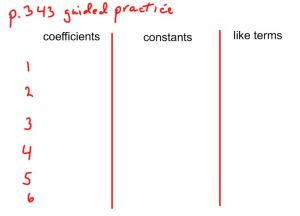Was I a bad teacher today? I made my students partner read three textbook pages on identifying constants, coefficients, and like terms. After reading they were to complete six practice problems as a check for understanding. I wanted them to be successful, so I posted a table to make it easier to compare and discuss each problem.
They were stumped with the first one.
I expected the students would run into trouble. They say they read, but they don’t read closely. Most rush which doesn’t help them develop an eye for the nuances—like in language arts where over time your eye becomes trained to catch missing words, sentence fragments, or a lack of support in a paragraph.
Here’s a screenshot of a section they read.
And here are the problems they were asked to complete. By the way the problems were located on the facing page, not very far away from the example.

As soon as I realized they were stuck on the first problem I gathered the class and asked, “What are the coefficients in problem one?”
Student: -3z and 4z.
“Not yet.”
Student: 3z and 4z.
“Look at the example. How can that help you?”
I recognized they needed the textbook under the document camera, so I projected the worked example onto the screen. Here it is again.
“What are the coefficients in this expression?”
Student: “It says 1 and -2. (PAUSE) Why does it say 1 when a 1 isn’t there?
“Great question!” We hadn’t talked about how 1 is understood so we discussed that. However it was a missed opportunity on my part to ask if the student had asked himself that question when he first read the worked example. The train was now slowly leaving of the station. They were beginning to use their resource–the worked example–to help them identify the constants, coefficients, and like terms.
The second problem required students to apply integer rules. Most wanted to identify the coefficient as 9 instead of -9, same with the constant -6. They still haven’t developed the eye to recognize subtraction as adding a negative.
For homework they’re to complete the other four problems. Tomorrow will be more in class practice and I’ll assign this practice video for homework.



I don’t think you were a bad teacher. I have been working on these topics for the first time. I now (a little too late this year) realize I hadn’t spent enough time discussing the specifics of the terms and have been thinking about how to adjust for next year. I like your idea. I also think it bring more of the Literacy CCSS into Math.
This year’s school improvement plan focuses on implementing both reading and thinking strategies in all subject areas. I could have done a better job of establishing the purpose for reading and asking students to monitor. Some students just see words and don’t process what they’re reading. Others find it easier to be told what to do rather than think and figure it out for themselves. Still others rush and miss important. I have to remember: they’re kids!
Thanks for taking the time to comment.